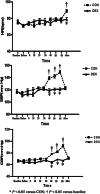Preoperative dexmedetomidine prevents tourniquet-induced hypertension in orthopedic operation during general anesthesia
- PMID: 23639514
- PMCID: PMC11916225
- DOI: 10.1016/j.kjms.2012.09.006
Preoperative dexmedetomidine prevents tourniquet-induced hypertension in orthopedic operation during general anesthesia
Abstract
This study was a double-blinded randomized control trial designed to investigate the hemodynamic effects of dexmedetomidine on prolonged tourniquet inflation. Thirty-seven patients scheduled for elective orthopedic surgery of the lower limb under general anesthesia were recruited. They were randomly assigned to receive intravenous dexmedetomidine (DEX, 0.5 μg/kg; n = 18) or normal saline (CON; n = 19) before tourniquet inflation. Arterial blood pressure and heart rate were recorded every 10 minutes until 60 minutes after the start of tourniquet inflation and again immediately after deflation. In the DEX group, arterial pressure was not significantly changed, but in the CON group arterial pressure was significantly increased at 40, 50, and 60 minutes after the start of tourniquet inflation. Development of more than 30% increase in arterial pressure during tourniquet inflation was more frequent in the CON group than in the DEX group. Preoperative intravenous dexmedetomidine could therefore prevent tourniquet-induced hypertension in patients undergoing general anesthesia.
Copyright © 2012. Published by Elsevier B.V.
Figures

References
-
- Tetzlaff J.E., O'Hara J., Yoon H.J., Schubert A.. Tourniquet‐induced hypertension correlates with autonomic nervous system changes detected by power spectral heart rate analysis. J Clin Anesth. 1997; 9: 138–142. - PubMed
-
- Hagenouw R.R., Bridenbaugh P.O., van Egmond J., Stuebing R.. Tourniquet pain: a volunteer study. Anesth Analg. 1986; 65: 1175–1180. - PubMed
-
- Valli H., Rosenberg P.H., Kytta J., Nurminen M.. Arterial hypertension associated with the use of a tourniquet with either general or regional anaesthesia. Acta Anaesthesiol Scand. 1987; 31: 279–283. - PubMed
-
- Valli H., Rosenberg P.H.. Effects of three anaesthesia methods on haemodynamic responses connected with the use of thigh tourniquet in orthopaedic patients. Acta Anaesthesiol Scand. 1985; 29: 142–147. - PubMed
-
- Zalunardo M.P., Serafino D., Szelloe P., Weisser F., Zollinger A., Seifert B., et al. Preoperative clonidine blunts hyperadrenergic and hyperdynamic responses to prolonged tourniquet pressure during general anesthesia. Anesth Analg. 2002; 94: 615–618. - PubMed
Publication types
MeSH terms
Substances
LinkOut - more resources
Full Text Sources
Other Literature Sources
Medical

